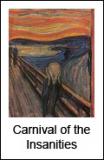Jules Crittenden has a roundup of numerous sources looking at this horrid crime. Our deepest sympathy and condolences go out to those injured and killed, as well as their parents, friends and loved ones.
Reaction in America is still muted for the most part, as people try to come to grips with reality. In Europe, America-bashing is already in full swing over our gun laws.
Glen Reynolds at Instapundit puts the gun issue in perspective in an editorial he authored today in the N.Y. Daily News:. . . If there were more responsible, armed people on campuses, mass murder would be harder.
In fact, some mass shootings have been stopped by armed citizens. Though press accounts downplayed it, the 2002 shooting at Appalachian Law School was stopped when a student retrieved a gun from his car and confronted the shooter. Likewise, Pearl, Miss., school shooter Luke Woodham was stopped when the school's vice principal took a .45 fromhis truck and ran to the scene. In February's Utah mall shooting, it was an off-duty police officer who happened to be on the scene and carrying a gun.
Police can't be everywhere, and as incidents from Columbine to Virginia Tech demonstrate, by the time they show up at a mass shooting, it's usually too late. On the other hand, one group of people is, by definition, always on the scene: the victims. Only if they're armed, they may wind up not being victims at all.
"Gun-free zones" are premised on a fantasy: That murderers will follow rules, and that people like my student, or Bradford Wiles, are a greater danger to those around them than crazed killers like Cho Seung-hui. That's an insult. Sometimes, it's a deadly one.
And this in the WSJ by David KopelThe bucolic campus of Virginia Tech, in Blacksburg, Va., would seem to have little in common with the Trolley Square shopping mall in Salt Lake City. Yet both share an important characteristic, common to the site of almost every other notorious mass murder in recent years: They are "gun-free zones."
Forty American states now have "shall issue" or similar laws, by which officials issue a pistol carry permit upon request to any adult who passes a background check and (in most states) a safety class. Research by Carlisle Moody of the College of William and Mary, and others, suggests that these laws provide law-abiding citizens some protection against violent crime. But in many states there are certain places, especially schools, set aside as off-limits for guns. In Virginia, universities aren't "gun-free zones" by statute, but college officials are allowed to impose anti-gun rules. The result is that mass murderers know where they can commit their crimes.
Private property owners also have the right to prohibit lawful gun possession. And some shopping malls have adopted anti-gun rules. Trolley Square was one, as announced by an unequivocal sign, "No weapons allowed on Trolley Square property."
In February of this year a young man walked past the sign prohibiting him from carrying a gun on the premises and began shooting people who moments earlier were leisurely shopping at Trolley Square. He killed five.
Fortunately, someone else -- off-duty Ogden, Utah, police officer Kenneth Hammond -- also did not comply with the mall's rules. After hearing "popping" sounds, Mr. Hammond investigated and immediately opened fire on the gunman. With his aggressive response, Mr. Hammond prevented other innocent bystanders from getting hurt. He bought time for the local police to respond, while stopping the gunman from hunting down other victims. . . .
Wednesday, April 18, 2007
Mass Murder at Virginia Tech
Posted by
scott
at
1:13 PM
![]()
Labels: Cho Seung-hui, gun control, gun crime, gun free zones, mass murder, massacre, Virginia Tech
Subscribe to:
Post Comments (Atom)



No comments:
Post a Comment